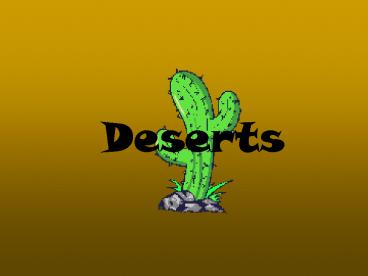Deserts - PowerPoint PPT Presentation
1 / 7
Title:
Deserts
Description:
Most of Utah's natural state is desert. Desert Plants Prickly Pear Cactus The prickly pear cactus has adaptations to help it survive the hot desert habitat. – PowerPoint PPT presentation
Number of Views:159
Avg rating:3.0/5.0
Title: Deserts
1
Deserts
2
Dazzling Desert
- An area of land that receives less than ten
inches of rainfall a year.
Take a look outside. What is it like where you
live? You may see grass, large pine trees, or
green leafy trees around your school and
neighborhood. The water we use for these
plants comes from streams, rivers, lakes, and
deep underground wells. This is how people living
in Utah maintain their beautiful yards and
gardens. Yet, Utah is the second driest state in
the United States. Nevada is the driest. Imagine
if all of the water sprinklers were shut off for
several years. The environment would look much
different because many of the trees and
other plants would die. Eventually, plants that
are adapted to drier climates would return. Most
of Utah's natural state is desert.
3
Desert Plants
- Prickly Pear Cactus
The prickly pear cactus has adaptations to help
it survive the hot desert habitat. The leaves
have thick waxy covering which helps keep the
water inside the plant longer. The spines of
needles on the cactus protect it from sun and
wind. The prickly pear cactus blossoms in the
spring with pink, yellow, and orange blossoms
providing nectar for bees and moths.
Sagebrush
Sagebrush is a very common desert plant
throughout Utah. It grows about four feet tall
and gives off a very strong odor. Sagebrush is
used by some animals for shade, protection from
predators, and food for mule deer, caterpillars,
and other animals. When land is cleared for
houses or other buildings, sagebrush is
destroyed. It is very slow to reproduce, and
animals that depend on sagebrush die.
4
Other Desert Plants that provide shelter, food
and protection for desert animals
- Pinyon Pine
- Utah Juniper
5
Desert Animals
Insects
Reptiles
Mammals
Birds
Spiders
Many animals find cooler places to stay during
the hot hours of the day. They burrow into the
ground or find shady spots by rocks or plants.
Some animals of the desert do not require large
amounts of water. They get the water they need
from plants or possibly from a water hole.
6
More Animals
- The Jackrabbit
The jackrabbit is a common desert animal of Utah.
To keep out of the sun on hot days, the
jackrabbit stays hidden under shrubs or near
clumps of grass. They also lose body heat through
their very large ears to keep cool. The
jackrabbit uses ear-conditioning to lose
one-third of its body heat. In the cooler morning
and evenings it feeds on prickly pear cactus. The
jackrabbit can run up to 35 miles per hour to
escape predators such as coyotes, foxes and large
snakes.
7
Rattlesnakes
- A rattlesnake lives in rocky areas and
stays in the shade of a tree or bush during the
day. However, at night it becomes very active as
it hunts for food. The rattlesnake usually bites
a small animal, such as the kangaroo rat, with
its poisonous fangs, and swallows the animal
whole. To survive the winter, rattlesnakes
hibernate within a large group in underground
holes.
Desert Tortoise
The desert tortoise lives in the hot desert. It
moves very slowly across the desert sand.
Prairie Dog
Both the desert tortoise and the prairie dog are
endangered and protected by laws.
Prairie dogs dig holes and burrow under the
ground, where it is cooler.































